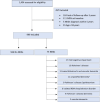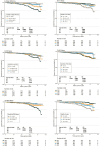Sleep features and long-term incident neurodegeneration: a polysomnographic study
- PMID: 38001022
- PMCID: PMC10925953
- DOI: 10.1093/sleep/zsad304
Sleep features and long-term incident neurodegeneration: a polysomnographic study
Abstract
Study objectives: Sleep is altered early in neurodegenerative diseases (NDDs) and may contribute to neurodegeneration. Long-term, large sample-size studies assessing NDDs association with objective sleep measures are scant. We aimed to investigate whether video-polysomnography (v-PSG)-based sleep features are associated with long-term NDDs incidence.
Methods: Retrospective cohort study of patients referred 2004-2007 to the Sleep Disorders Unit, Neurology, Medical University Innsbruck, Austria. All patients ≥ 18 years undergoing v-PSG and without NDDs at baseline or within 5 years were included. Main outcome was NDDs diagnosis ≥5 years after v-PSG.
Results: Of 1454 patients assessed for eligibility, 999 (68.7%) met inclusion criteria (68.3% men; median age 54.9 (IQR 33.9-62.7) years). Seventy-five patients (7.5%) developed NDDs and 924 (92.5%) remained disease-free after a median of 12.8 (IQR 9.9-14.6) years. After adjusting for demographic, sleep, and clinical covariates, a one-percentage decrease in sleep efficiency, N3-, or rapid-eye-movement (REM)-sleep was associated with 1.9%, 6.5%, or 5.2% increased risk of incident NDDs (HR 1.019, 1.065, and 1.052). One-percentage decrease in wake within sleep period time represented a 2.2% reduced risk of incident NDDs (HR 0.978). Random-forest analysis identified wake, followed by N3 and REM-sleep percentages, as the most important feature associated with NDDs diagnosis. Additionally, multiple sleep features combination improved discrimination of incident NDDs compared to individual sleep stages (concordance-index 0.72).
Conclusions: These findings support contribution of sleep changes to NDDs pathogenesis and provide insights into the temporal window during which these differences are detectable, pointing to sleep as early NDDs marker and potential target of neuroprotective strategies.
Keywords: Alzheimer’s disease; Parkinson’s disease; dementia biomarkers; objective sleep cohort study; polysomnography.
© The Author(s) 2023. Published by Oxford University Press on behalf of Sleep Research Society.
Figures



Comment in
-
Wake, NREM, and REM sleep measures predict incident dementia.Sleep. 2024 Mar 11;47(3):zsad329. doi: 10.1093/sleep/zsad329. Sleep. 2024. PMID: 38158613 Free PMC article. No abstract available.
References
-
- World Health Organization (WHO), Global status report on the public health response to dementia. 2021. https://www.who.int/publications/i/item/9789240033245. Accessed July, 2022.
MeSH terms
LinkOut - more resources
Full Text Sources
Miscellaneous

